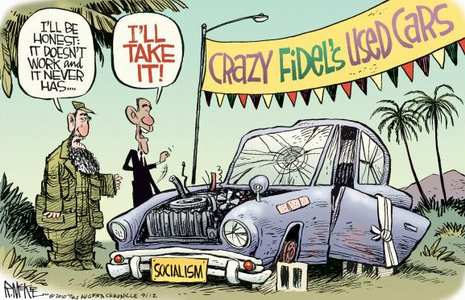In 1859, English naturalist Charles Darwin claimed that something could come from nothing, life from non-life, personality from non-personality, and man from non-man. He also imagined that a series of pure random processes would result in continuously increased complexity. Now, Mr Darwin didn’t allow the fact that his theories contradicted the laws of physics, the laws of reason, and the laws of science dissuade him. He simply announced that it was possible if the process was given enough time, namely billions of years.
Likewise, the Obama administration believes that higher taxes, runaway government spending (leading to higher inflation), re-distribution of wealth, and other job-killing policies will produce economic growth if given enough time. To his credit, Mr Gibbs did not theorize that it would take billions of years, but when asked to clarify what he meant, he said, “it’s going to take several years.”
 Fortunately, we can reasonably hope that, unlike macro-evolution, free enterprise can eventually overcome these devastating policies. Unfortunately, judging by past history, the more a liberal government interjects itself in an attempt to fix the problem, the longer the problem lasts. Mr Obama, Ms Pelosi, Mr Reid and associates urge us to look to the future, but their ideology is firmly rooted in the past, from the “manufactured crisis” design of German philosopher GWF Hegel (18-19th century) to the economic concepts of 19th century German philosopher Karl Marx. Even Cuban dictator Fidel Castro recently admitted that socialism is an absolute failure as an economic system. Yet Mr Obama and friends persist in pushing these disastrous policies.
Fortunately, we can reasonably hope that, unlike macro-evolution, free enterprise can eventually overcome these devastating policies. Unfortunately, judging by past history, the more a liberal government interjects itself in an attempt to fix the problem, the longer the problem lasts. Mr Obama, Ms Pelosi, Mr Reid and associates urge us to look to the future, but their ideology is firmly rooted in the past, from the “manufactured crisis” design of German philosopher GWF Hegel (18-19th century) to the economic concepts of 19th century German philosopher Karl Marx. Even Cuban dictator Fidel Castro recently admitted that socialism is an absolute failure as an economic system. Yet Mr Obama and friends persist in pushing these disastrous policies.
Mr Obama, Ms Pelosi, and Mr Reid constantly proclaim that the stimulus and other measures have saved two, three and even five million jobs (whatever number happens to pop into their heads at the moment). While these numbers can’t be verified (a primary reason why they continually float them), we can certainly look at some historical examples.
Nationally syndicated writer Larry Elder, in his Listen, dummies: Obama's stimulus 'clearly helped' article, contrasts the approach of Ronald Reagan to that of Franklin Roosevelt:
President Reagan, in the early '80s, inherited an economy with 13.5 percent inflation, 21 percent prime interest rates, and an unemployment rate that reached 10.8 percent. He addressed this by doing the opposite of what Obama has done. Reagan sharply lowered taxes, dropping the top marginal rate from 70 percent to 28 percent. He slowed the rate of domestic spending. And he continued the deregulation policies of President Carter. Interest rates fell, inflation declined and unemployment, after nearly two years, started dropping.We’ll have more on the Great Depression in upcoming posts, but we’ll offer one more piece of the puzzle here. FDR is widely credited with leading a government intervention that lifted the country out of this depression, but let’s look at the facts.President Franklin D. Roosevelt, during the Great Depression, continued the tax-hiking policies of his predecessor. Federal spending soared. The result? Unemployment during the Depression reached 25 percent and remained stuck in the teens until World War II. The subsequent destruction of foreign economies, which America helped rebuild, sparked a domestic boom. The dismantling of ill-advised worldwide trade barriers also helped.
FDR's secretary of Treasury, Henry Morgenthau, who served from 1934 to 1945, wrote in 1939: “We have tried spending money. We are spending more than we have ever spent before and it does not work. I want to see this country prosperous. I want to see people get a job. I want to see people get enough to eat. We have never made good on our promises. ... I say after eight years of this administration we have just as much unemployment as when we started ... and an enormous debt to boot!”
Even after the stock market crash of October 1929, at no time during the following twelve months did unemployment reach double digits. Two months after the crash, unemployment peaked at about 9 percent, and then began trending downward over the next six months, finally reaching 6.3 percent by June 1930. At this point, the federal government decided to step in to fix the imaginary crisis and proceeded to create a real crisis.
So, if history teaches us anything about economics, it is that the federal government should get out of the way and allow the free enterprise system to work.
Love the cartoon. It would be even funnier if it wasn't so accurate.
ReplyDeleteGood article. Thanks for the info on the great depression. I know there's a lot of myths floating around. Many people on the left still worship FDR for his "economic vision". I think he did some brave things with the war but his economic policies started us down the road to ruin.
ReplyDelete